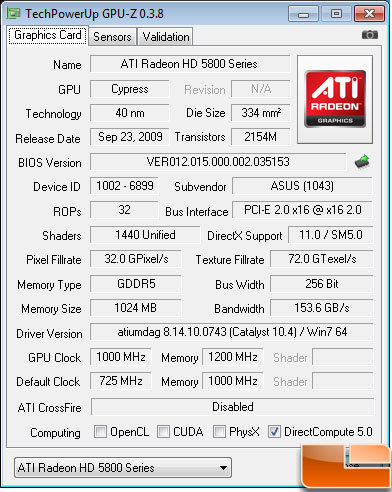ASUS Radeon HD EAH5850 DirectCU TOP Video Card Review
Overclocking & Power Consumption
As we’ve already established, the ASUS EAH5850 TOP is already overclocked out of the box, but what happens when you want a little more? ASUS informed us that each of these cards will run with no problems at 800MHz. For those of you who still want more we decided to push this card to our comfortable limits using the ASUS Smart Doctor utility.

Out of the gate without touching the voltage, we were able to reach 950MHz GPU core and 1175MHz memory, or a 185MHz and 25MHz increase respectively! This is a massive improvement on the GPU over the default clocks of 765/1125. Still though, we weren’t satisfied until we could get to 1GHz on the GPU.

By stepping the voltage up to 1.24v through the Smart Doctor Utility, we were able to reach 1GHz on the GPU! This is a 275MHz jump over a reference Radeon HD 5850 and 235MHz over the shipping clocks of our ASUS EAH5850 TOP. We were also able to bump memory speed up to 1200MHz.

We were able to complete a run of 3D Mark Vantage at our overclocked setting. Overall our score increased by nearly 2500 points over the reference Radeon HD 5850! The above is a screen shot of Afterburner taken after the run was complete.
Power consumption
Power consumption is something that is becoming a bigger concern for some gamers. Typically, the more power consumed the more heat that is put out. It also means higher electric bills! Power under load can be justified because it’s one of those the tradeoff’s to have a high performing graphics card. However, idle power consumption can be very important for anyone that leaves their system on 24/7.
For testing power consumption, we took our test system and plugged it into a Seasonic Power Angel. For idle numbers, we allowed the system to idle on the desktop for 15 minutes and took the reading. For load numbers, we measured the peak wattage used by the system while running 3DMark Vantage.

At idle, both cards reduce clock speed and voltage to the same level and show no difference at all. Once under a load that changes a bit, with the ASUS EAH5850 TOP consuming an extra 14 Watts more than the reference Radeon HD 5850.

Comments are closed.